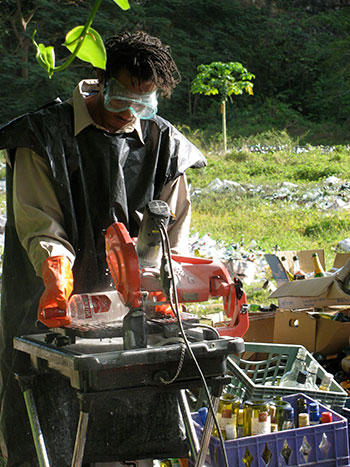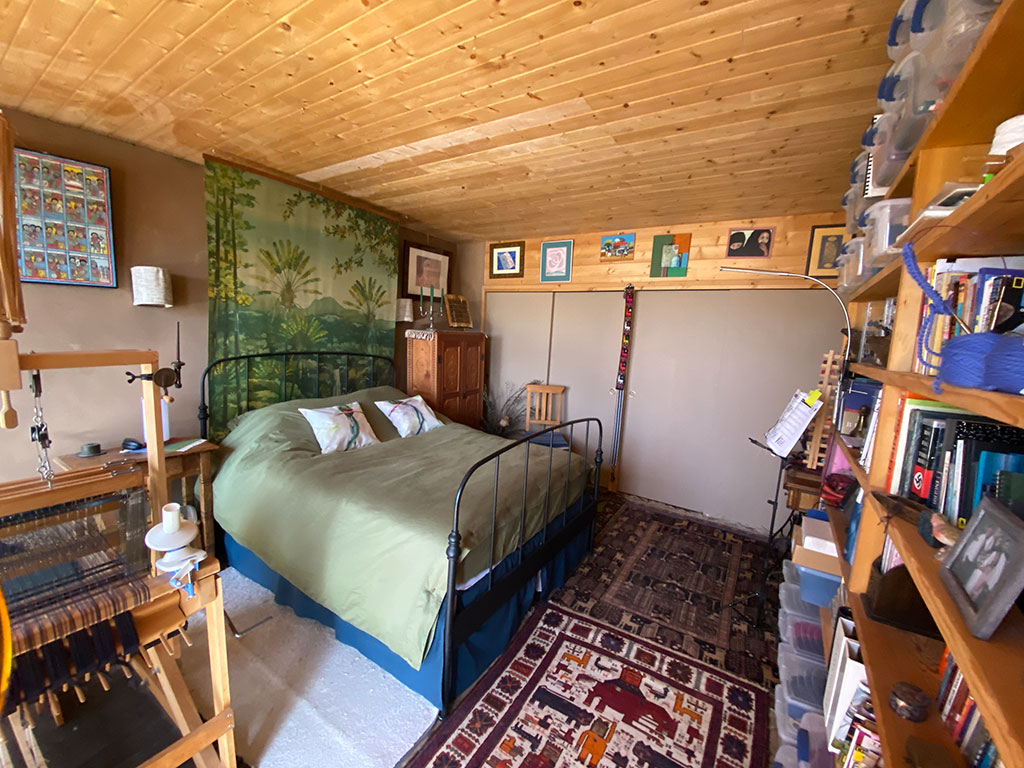A Quick and Easy, step by step on how to make bottle bricks.
Bottle bricks allow light to shine through a wall, and color the light the color of the glass used in the brick.
A bottle brick is made up of the bottom 4″ or 5″ of a bottle. (depending on the size of your bottle brick and thickness of your wall).
- Get a basic ceramic tile saw, much like a table saw. These are available from your local hardware store for under $100. These ceramic tile saws come with a little trough of water. The diamond tipped blade runs through this water to cool off the blade.
- Be sure to wear thick rubber gloves. The ‘bluettes‘ brand works very well, check amazon.
- Adjust the fence of ceramic tile saw to be 4 inches from the blade.
- Place the butt of the bottle against the ceramic tile saw fence and move it slowly to the blade. Rotate the bottle toward you as you make contact with the blade.
- The first rotation or two can be just to ‘score’ the bottle. Following rotations can be little further into the blade to cut the bottle along the previously ‘scored’ line. This will help to have a clean cut and not break the bottle.
- When you have the butts of the bottles cut off at 4″ each, you are ready to tape the two parts together. A good method is to cut a lot of the bottle butts, then move to taping all the butts. The bottle bricks should be the same diameter when make the bottle bricks.
- All of the butts should be cleaned and completely dry.
- Taping the butts can be done with clear or non-clear tape. The light will enter the ends, not the sides… so covering the sides with non-clear tape wont make a difference.

Recycling glass bottles is a great way to create a stunning and unique wall… a wall by itself, or a wall in your home, commercial building, garden, etc.
They are easy to make and with such a variety of colours and shapes out there, so many different designs can be made!
This is a building construction style which usually uses glass bottles (although mason jars, glass jugs, and other glass containers may be used also) as masonry units and binds them using adobe, sand, cement, stucco, clay, plaster, mortar or any other joint compound. This results in an intriguing stained-glass like wall.
Athough bottle walls can be constructed in many different ways, they are typically made on a foundation that is set into a trench in the earth to add stability to the wall. The trench is filled with a rubble of pea gravel and then filled in with cement. Rebar can be set into the foundation to add structural integrity. Bottle walls range one bottle to two bottles thick. Primitive mixture, such as cob or adobe can be used as mortar to bind the bottles. It is thickly spread on the previous layer of bottles followed by the next layer which is pressed into the mixture. Typically two fingers of separation are used as a means of spacing although any kind of spacing can be achieved.
Bottles can also be duct taped together to create a window-type effect. Two similar size bottles can be taped together with the openings allowing a light passage way. This also traps air and creates a small amount of insulation. Filling glass with liquid that will be subjected to freezing and thawing is not a good idea, but is useful if the glass is protected from temperature extremes.
Bottle Walls Throughout History
The use of empty vessels in construction dates back at least to ancient Rome, where many structures used empty amphorae embedded in concrete. This was not done for aesthetic reasons, but to lighten the load of upper levels of structures, and also to reduce concrete usage. This technique was used for example in the Circus of Maxentius.
It is believed that the first bottle house was constructed in 1902 by William F. Peck in Tonopah, Nevada. The house was built using 10,000 bottles of J. Hostetter’s Stomach Bitters which consisted of various herbs in a solution of 47% alcohol. The Peck house was demolished in the early 1980s.[citation needed] Rhyolite bottle house

Around 1905, Tom Kelly built his house in Rhyolite, Nevada, using 51,000 beer bottles masoned with adobe. Kelly chose bottles because trees were scarce in the desert. Most of the bottles were Busch beer bottles collected from the 50 bars in this Gold Rush town. Rhyolite became a ghost town by 1920. In 1925, Paramount Pictures discovered the Bottle House and had it restored for use in a movie. It then became a museum, but tourism was slow, causing it to close. From 1936-1954, Lewis Murphy took care of the house and hosted tourists. From 1954-1969, Tommy Thompson occupied the house. He tried to make repairs to the house with concrete which, when mixed with the desert heat, caused many bottles to crack (Kelly had used adobe mud).
Knott’s Berry Farm in Buena Park, California, has a bottle house, made from over 3,000 whiskey bottles, that it uses as an “Indian Trader” store today. The house is a remake of the Rhyolite Bottle House replicated from photos taken by Walter Knott in the early 1950s.

Another famous bottle house site was built by the self-taught senior citizen Tressa “Grandma ” Prisbrey. Located in Simi Valley, California, Bottle Village is lauded by art scholars, The State of California, The National Register of Historic Places and in exhibitions, as a major artistic achievement. Beginning construction in 1956 at age 60, and working until 1981, Tressa “Grandma” Prisbrey transformed her 1/3 acre lot into Bottle Village, an otherworld of shrines, wishing wells, walkways, random constructions, plus 15 life size structures all made from found objects placed in mortar. The name “Bottle Village” comes from the structures themselves – made of tens of thousands of bottles unearthed via daily visits to the dump.

The Washington Court Bottle House in Ohio was made with 9,963 bottles of all sizes and colors. The builder was a bottle collector and, to display his collection, he had them built into this house which was on display at Meyer’s Modern Tourist Court. In Alexandria, Louisiana, there is a bottle-house gift shop that still stands today. The bottle house was constructed by Drew Bridges who used bottles from his drugstore. There are about 3,000 bottles used as masonry units with railroad ties used as the framing structure.

The Kaleva Bottle House in Kaleva, Michigan, was built by John J. Makinen, Sr.(1871-1942) using over 60,000 bottles laid on their sides with the bottoms toward the exterior. The bottles were mostly from his company, The Northwestern Bottling Works. The house was completed in 1941, but he died before he could move in. The building was purchased by the Kaleva Historical Museum in 1981 and is listed on the National Register of Historical Places. Boston Hills Pet Memorial Park in Boston, Massachusetts, has a bottle wall from 1942. It is part of a small building used for storage. The Wimberley Bottle House in Wimberley, Texas, was constructed using over 9,000 soda bottles. It was built in the early 1960s as part of a pioneer town, a simulated Old West town set to be a tourist attraction/theme park. The house was modeled after Knott’s Berry Farm bottlehouse in California.
Off-Grid Builders, Earthship Home Designs
Note: We design and build all over the USA and around the world.
What is a Biotecture Home?
A Biotecture building is a type of passive solar house that is made of both natural and upcycled materials (such as earth-packed tires). ‘Biotectures’ can be completely off-grid or partially off-grid.
Biotectures can be built in any part of the world, in any climate (with a permit) and still provide electricity, potable water, contained sewage treatment and sustainable food production.
Biotectures are thermal mass homes first, passive solar homes second.
Whatever temperature goes into a Biotecture building, it will hold… and since it is also a Passive Solar House, it is also very tight and interacts only with the sun and the earth for heating and cooling, providing stable comfort year round in any climate. This results in being able to provide a sustainable home on property that may not be situated to the ideal of 13.5 degrees east of south.





Leave A Comment